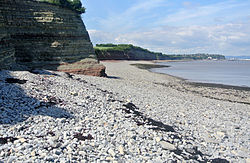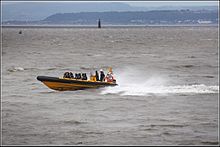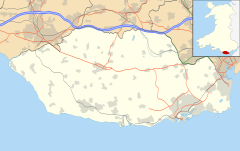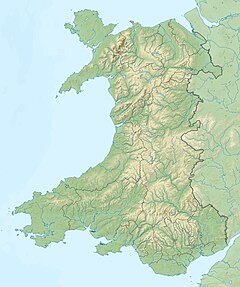Lavernock Point
Lavernock
|
|
|---|---|
 Lower Blue Lias rocks exposed at Lavernock Point |
|
| Lavernock shown within the Vale of Glamorgan | |
| Principal area | |
| Ceremonial county | |
| Country | Wales |
| Sovereign state | United Kingdom |
| Postcode district | CF |
| Police | South Wales |
| Fire | South Wales |
| Ambulance | Welsh |
| EU Parliament | Wales |
| UK Parliament | |
| Welsh Assembly | |

Monkstone Light in 2012
|
|
| Location | Lavernock Bristol Channel Wales United Kingdom |
|---|---|
| Coordinates | 51°24′53″N 3°6′0″W / 51.41472°N 3.10000°W |
| Year first constructed | 1839 (first) |
| Year first lit | 1993 (current) |
| Construction | stone tower first-stage, fiberglass tower second-stage |
| Tower shape | two-stages cylindrical tower with double balcony and small lantern |
| Markings / pattern | black lower stage tower, red upper stage tower |
| Height | 23 m (75 ft) |
| Focal height | 13 m (43 ft) |
| Light source | solar power |
| Intensity | 3,976 candela |
| Range | 12 nmi (22 km) |
| Characteristic | Fl W 5s. |
| Admiralty number | A5428 |
| NGA number | 5864 |
| ARLHS number | WAL-043 |
| Managing agent |
Trinity House |
Lavernock (Welsh: Larnog) is a hamlet in the Vale of Glamorgan in Wales, lying on the coast 7 miles (11 km) south of Cardiff between Penarth and Sully, and overlooking the Bristol Channel.
Following overland tests at Salisbury Plain during March 1897, on 13 May 1897, the Italian born and recently British based inventor, best known for his development of a radiotelegraph system, Guglielmo Marconi, assisted by George Kemp (who was a Cardiff based Post Office engineer) transmitted and received the first wireless signals over open sea between Lavernock Point and Flat Holm island.
The very first message transmitted in morse code was "ARE YOU READY". This was immediately followed by "CAN YOU HEAR ME" to which the reply was "YES LOUD AND CLEAR". The morse recording slip for the first message is on display in the National Museum of Wales.
Following the initial opening exchange there followed detailed technical messages in both directions indicating each end's equipment settings and receiving sound levels. Marconi indicated that he was using a 20-inch (510 mm) spark on his equipment.
The successful test followed several days of trials and failure while adjustments were made to aerial length. Extensive trials were carried out over the remainder of the week in various weather conditions and with different settings on the equipment at each end. Marconi benefitted from the active encouragement of then Mr. William Preece (later Sir William Preece) who was Engineer-in-Chief of the Post Office and had himself transmitted radio telegraph morse signals across Coniston Water eight years earlier. Preece had been previously acted as a consultant to the Bristol Corporation's Electricity Department between 1883 and 1893. The Post Office engineers, including George Kemp who kept a detailed diary of these events, had been experimenting for some months at Lavernock Point. Kemp recorded the following in his diary of the experiments:
...
Wikipedia


